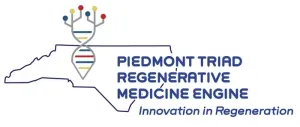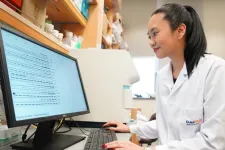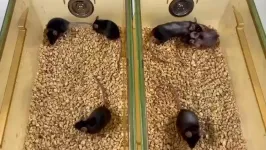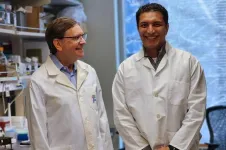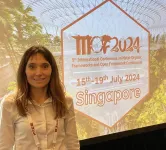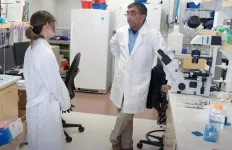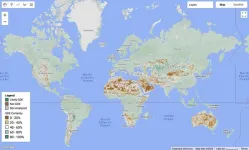(Press-News.org) Winston-Salem, North Carolina — July 17, 2024 — The RegeneratOR Test Bed, located in Innovation Quarter, announces the inclusion of Cytoink into its pioneering ecosystem dedicated to advancing biomedical research and development. Cytoink brings cutting-edge biomaterials manufacturing, with over 100 custom formulations, and bioprinting expertise that merges biofunctionality with high-throughput production. Cytoink specializes in the biofabrication of in vitro 3D tissue phantoms, extrusion-based and light-based (DLP/VAM) bioinks, and integrated perfusion microfluidics bioreactors. Additionally, Cytoink provides bespoke biomaterial solutions and advanced 3D tissue modeling services from concept to minimal viable product runs.
Cytoink is committed to shaping the future of biomedical R&D by emphasizing precision and efficiency, thereby revolutionizing traditional approaches and minimizing reliance on animal testing. Their innovative solutions aim to accelerate scientific progress while ensuring robust and reliable outcomes.
Bioinks, which are used to print complex tissues, are substances made of living cells suspended in polymers or hydrogels. These “inks” are used in printing devices to formulate scaffolds for cell expansion, or entire 3D printed organs and tissues.
"At Cytoink, we envision a future where accuracy and speed are the cornerstones of biomedical research, driving impactful healthcare outcomes," said Martin Tomov, co-founder of Cytoink. "We are thrilled to join the RegeneratOR Test Bed, a hub of innovation that aligns perfectly with our mission to empower research and industry leaders worldwide."
The RegeneratOR Test Bed, operated by the RegenMed Development Organization or ReMDO, is renowned for fostering collaborative environments where cutting-edge technologies converge to advance regenerative medicine and biomedical engineering. By welcoming Cytoink into its ecosystem, the Test Bed continues to expand its capabilities and influence within the biomedical community.
"We are excited to welcome Cytoink to the Test Bed," said Joshua Hunsberger, CTO of ReMDO. "Their expertise in biomaterials and commitment to innovation aim to accelerate the development of technologies that benefit both researchers and patients."
Cytoink's integration into the RegeneratOR Test Bed signifies continued steps to build and support the Piedmont Triad RegenMed Engine, a part of the inaugural National Science Foundation (NSF) Innovation Engines program. In this ecosystem, research in biomedical innovation works to pioneer new standards in biotechnology, facilitating breakthroughs that enhance global health outcomes.
About Cytoink: Cytoink specializes in tunable biomaterials and custom bioengineered solutions with a focus on human-relevant 3D phantoms, tissue-specific bioinks, and functional surface coatings. With a focus on precision and speed, Cytoink helps minimize failures, reduce animal testing, and speed up the path to clinical trials while lowering R&D costs.
For more information about Cytoink and their groundbreaking solutions, visit www.cytoink.com, or email directly at info@cytoink.com.Media Contact: Mihail Stoykov, mihail@cytoink.com
About ReMDO: The RegenMed Development Organization (ReMDO) is a 501(c)3 non-profit with a mission to help deliver on the promise of regenerative medicine by advancing research to de-risk technologies, promoting progress of biomanufacturing scale-up and automation to make technologies more affordable, and speeding up the translation to clinical practice. For more information, visit http://remdo.org.
For inquiries regarding the RegeneratOR Test Bed and partnership opportunities, please contact Joshua Hunsberger, at joshua.hunsberger@remdo.org.
Media Contact: Emily Gregg, egregg@wakehealth.edu
END
RegeneratOR Test Bed welcomes Cytoink to accelerate biomedical innovations
2024-07-17
ELSE PRESS RELEASES FROM THIS DATE:
Jeffrey Spraggins named director of Vanderbilt University Mass Spectrometry Research Center
2024-07-17
Jeffrey Spraggins, associate professor of cell and developmental biology, biochemistry, and chemistry, has been named director of the Mass Spectrometry Research Center. He succeeds Richard Caprioli, Stanford Moore Chair in Biochemistry, who established the MSRC in 1998 and who is retiring this summer.
Spraggins is a leading scientist in spatial biology and imaging mass spectrometry—an untargeted molecular imaging approach that enables molecular mapping at cellular resolution—a technology originated by Caprioli. Spraggins’ research lies at the intersection of technology development, data science, and biomedical research. His research group ...
Duke-NUS finding advances quest to slow ageing
2024-07-17
An ageing population will bring colossal health, social, and economic challenges over the coming decades[1]. As people live longer, staving off the physical decline and frailty that come with age has become a holy grail, with effective interventions projected to unlock significant societal and economic benefits. Estimates suggest that a slowdown in ageing that increases life expectancy by one year alone is worth US$38 trillion.[2]
In a discovery published in Nature, a team of scientists from Duke-NUS Medical School in Singapore may have found a key to slow ageing.
The ...
Logged forests can still have ecological value – if not pushed too far
2024-07-17
Researchers have analysed data from 127 studies to reveal ‘thresholds’ for when logged rainforests lose the ability to sustain themselves.
The results could widen the scope of which forests are considered ‘worth’ conserving, but also show how much logging degrades forests beyond the point of no return.
The first-of-its-kind study, led by researchers from the Department of Life Sciences at Imperial College London with collaborators from around the world, is published today in ...
Exoplanet caught in ‘hairpin turn’ signals how high-mass gas giants form
2024-07-17
UNIVERSITY PARK, Pa. — Astronomers have discovered a planet that has the most oblong orbit ever found among transiting planets. The exoplanet’s extreme circuit — which looks closer to a cucumber than a circle — follows one of the most drastically stretched-out orbits of all known exoplanets, planets that orbit stars outside our solar system. It is also orbiting its star backwards, lending insight into the mystery of how close-in massive gas planets, known as hot Jupiters, form, stabilize and evolve over time.
The research, led by Penn State scientists, was published today (July 17) in ...
Switching off inflammatory protein leads to longer, healthier lifespans in mice
2024-07-17
Scientists at the Medical Research Council Laboratory of Medical Science and Imperial College London have discovered that ‘switching off’ a protein called IL-11 can significantly increase the healthy lifespan of mice by almost 25%.
The scientists, working with colleagues at Duke-NUS Medical School in Singapore, tested the effects of IL-11 by creating mice that had the gene producing IL-11 (interleukin 11) deleted. This extended the lives of the mice by over 20% on average.
They also treated 75-week-old mice – equivalent to the age of about 55 years in humans – with an ...
New gene therapy for muscular dystrophy offers hope
2024-07-17
A new gene therapy treatment for Duchenne muscular dystrophy shows promise of not only arresting the decline of the muscles of those affected by this inherited genetic disease, but perhaps, in the future, repairing those muscles.
The UW Medicine-led research focuses on delivering a series of protein packets inside shuttle vectors to replace the defective DMD gene within the muscles. The added genetic code will then start producing dystrophin, the protein lacking in patients with muscular dystrophy.
Currently, there is no cure for the disease ...
Scientists bridge the 'valley of death' for carbon capture technologies
2024-07-17
A major obstacle for net zero technologies in combatting climate change is bridging the gap between fundamental research and its application in the real world.
This gap, sometimes referred to as ‘the valley of death’, is common in the field of carbon capture, where novel materials are used to remove carbon dioxide from flue gasses produced by industrial processes. This prevents carbon from entering the atmosphere, helping to mitigate the effects of climate change.
Chemists have proposed and ...
Genome recording makes living cells their own historians
2024-07-17
Genomes can now be entrusted to store information about a variety of transient biological events inside of living cells, as they happen, like a flight recorder collecting data from an aircraft.
“Our method, which goes by the acronym ENGRAM, aims to turn cells into their own historians,” said Dr. Jay Shendure, a professor of genome sciences at the University of Washington School of Medicine and scientific director of the Brotman Baty Institute for Precision Medicine. Shendure led the effort, together with Wei Chen, a former graduate student, and Junhong Choi, a former postdoctoral fellow. Junhong ...
USC Schaeffer Institute launches new initiative to improve public policy through behavioral science
2024-07-17
The USC Schaeffer Institute for Public Policy & Government Service announced a new initiative today that leverages behavioral science to create more effective public policy.
The Behavioral Science & Policy Initiative at the USC Schaeffer Institute will conduct research to understand people’s beliefs and behaviors to create policies and communication that better fit people’s needs. The initiative will focus on policy topics such as climate change, health, and food insecurity.
“We want to help policymakers make a difference,” said Wändi Bruine de Bruin, the initiative’s ...
Groundwater is key to protecting global ecosystems
2024-07-17
(Santa Barbara, Calif.) — Where hidden water tables meet the Earth’s surface, life can thrive even in the driest locations. Offering refuge during times of drought, shallow groundwater aquifers act like water savings accounts that can support ecosystems with the moisture required to survive, even as precipitation dwindles. As climate change and human water use rapidly deplete groundwater levels around the world, scientists and policy makers need better data for where these groundwater-dependent ecosystems exist.
Now, a new study maps ...
